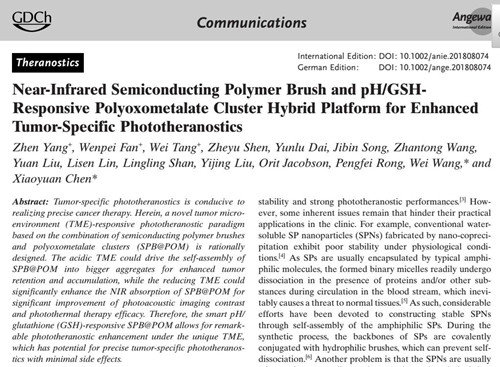The medical-engineering interdiscipline of special medicine has another piece of good news. The journalAngewandte Chemie International Edition(IF=12.102) published the original research result of Prof. Wang Wei from the Third Xiangya Hospital of Central South University and the overseas supervisors under the Wisdom Gathering and Talent Cultivating Program,Near-Infrared Semiconducting Polymer Brush and pH/GSH-Responsive Polyoxometalate Cluster Hybrid Platform for Enhanced Tumor-Specific Phototheranostics(2018-10-8, doi: 10.1002/anie.201808074), with the Third Xiangya Hospital of Central South University as the first unit and Prof. Wang as a co-corresponding author.

As an emerging noninvasive theranostic protocol for cancer, phototheranostics based on the integration of light-activated diagnosis and therapy has attracted extensiveattention from researchers and clinicians. The key is to build an efficient and multifunctional new material for light-driven tumor therapy. Distinct from most inorganic phototheranostic agents (e.g., gold-based nanoagents, and carbon-based materials), near-infrared absorbing organic semiconducting polymers (SPs) exhibit high thermal stability and strong phototheranostic performance, thus, it has potential for photoacoustic (PA) imaging and photothermotherapy (PTT) with minimal side effects. However, some inherent issues remain to hinder their practical applications in the clinic: (1) conventional water-soluble SP nanoparticles (SPNs) fabricated by nano-coprecipitation exhibit poor stability under physiological condition; (2) the SPNs are usually uptaken by tumor-adjacent tissues due to the relatively low passive targeting efficiency, which is a significant cause of mis-hyperthermia of noncancerous regions during PTT.
In the process of synthesizing SPB@POM nanoparticles, the team solved the former problem by covalently binding SP main chain and hydrophilic brush. Mo-based POMs, forming large aggregates in the tumor microenvironment (TME) through protonation-induced hydrogen bonding, may be anchored onto the surface of SPNs, which is strongly believed to realize the active targeting and responses to microenvironment and reduce mis-hyperthermia of noncancerous regions during PTT. Correcting the defects of rapid metabolism of POMs in the blood and reducing the dosage of SPs, this material has achieved a remarkable integration of light-activated diagnosis and therapy, which is expected to be used for precise cancer therapy in the future. This study provides an important methodological basis for constructing a photoacoustic/photothermal integrated light-activated diagnosis and therapy model.
This is another paper published in a Natural Index journal with CSU as the first unit, only second to the one in Adv. Funct. Mater. 2017, 27, 1606821 (IF= 13.325) owing to the cooperation between “Special Medicine” and “Material Science” of CSU. This highlights the necessity of the domestic and international development of themedical-engineering interdiscipline of special medicine, and indicates that original research results in this field are favored by the Natural Index journals.
Article link: https://onlinelibrary.wiley.com/doi/abs/10.1002/anie.201808074
Source: Third Xiangya Hospital











